|
Read 13122333 times
Connect me to:
|
TOPICS INCLUDE: Some Lou Wai Lou history, pictures, too; Old traditional channel/meridian picture; Mooncake naming and their contents; Longevity info; The train to Tibet; The Axi minorityLetters to the Editor
Summer Volume: 2013 Issue: 20(2) page(s): 9 and 33
From PANZHOU in Guangdong:
A friend asked me to inquire, as her English is not good enough to write to you though she can understand it when printed, why do you write so much about the Chinese minorities. She asks when will you have articles about more important Chinese cuisines?
PANZHOU: Tell your friend that all Chinese cuisines are important. One chap, Zhou Dasheng, who had the honor of being a Guest Fellow at Kyoto’s Museum of Ethnology, says that as a Han himself, he is extremely disappointed that Han or the ninety-four percent of China’s people, ignore the cuisines of the minorities in their own country. He says many Han speak as if they are a racially pure society; and they are not. He wrote that in the central plain of China during the Zhou period (1123 - 256 BCE) there were no Han people; all were known as Hua, Xia, or Hua-xia, and only after the founding of the Han Dynasty did they become known as Han, and that they were a culture with lots of interbreeding. He goes on to say that we cannot refer to the cuisine of China in the truest, broadest sense without mentioning the various minority cuisines, and that he and many others do appreciate these articles, and want more of them.
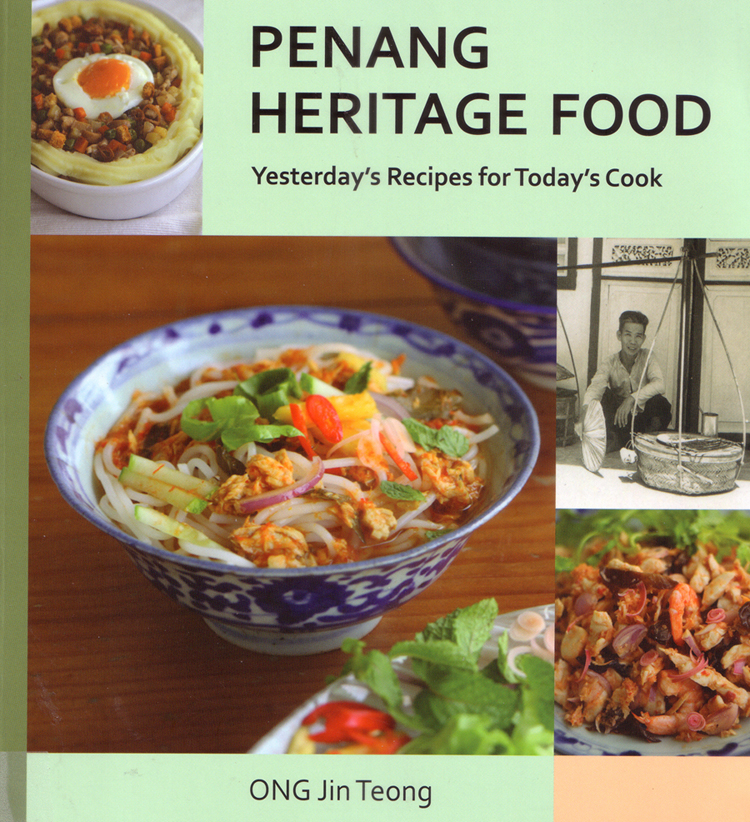 From BABA ONG JIN TEONG from Singapore: From BABA ONG JIN TEONG from Singapore:
Thank you for reviewing my cookbook Penang Heritage Food. I would like to clarify for you and your readers, there are differences between Penang and Singaporean Penanakan food. I once wrote in the Pernanakan, a magazine there on page 9 in issue 2, that within these countries when the same dish is cooked by different families, they can be misinterpreted as regional. Both cuisines have strong Malay and Hokkien influences from China, but Penang dishes are influenced by Thai, North Malaysian, and Hainanese tastes while those in Singapore often incorporate tastes from Indonesia. Singaporean food tends to be sweeter; this is not the case in Penang where Nonya foods share many commonly-used southern Thai ingredients and tastes. One example, Penangites slice then spoon some gravy over their appetizer rolls while Singaporeans eat theirs dry. Another difference, bamboo shoots make up a fair proportion of the filling in Singapore, but in Penang they are not commonly used. I have paraphrased from that article; it is titled: The Pearl and the Lion., and the pearl refers to Penang, known as the Pearl of the Orient, the Lion refers to Singapore as it is often called the Lion City because in Malay, Singa means lion. Those wanting to read the complete article can contact the publisher, The Peranakan Association Singapore at Raffles City, PO Box 1640, Singapore 91175, or go to www.peranakanorg.sg; and see it posted on their web site.
From DAISY on New York on Long Island:
Where the first Chinese health cures recorded? If you do not know, do you know a more appropriate food magazine with that kind of medical stuff?
DAISY: As the Chinese believe food is medicine and medicine is food, your query is most appropriate. Some of the earliest recorded pharmacological cures were excavated at Mawandui in the Hunan Province in the last decade or two. Said to be from 168 BCE, they are the earliest we know about. However, perhaps readers can help if they know earlier ones. Other early ones we know about were seven hundred years later when Tao Hong Jing compiled the Divine Farmers Canon of Materia Medica. Incidentally, about Mawandui, one article said they found seven medical manuscripts. We never saw them translated and do not know if they were about ritual incantations, yin and yang, or any specific prescriptions, but did read that they used more than one hundred substances including some to exorcize disease demons or their symptoms. Never read anything else about them, can any reader expand on this information?
From JACK in New York's Manhattan:
I seem to recall that there were a dozen longevity herbs used by the Chinese emperors. Can you tell us what they were and how successful they were in keeping these men alive?
JACK: Other than eight, the Chinese really like odd numbers, so we are suspicious about the fact you said twelve. We never heard of that many, and did do lots of asking around. Learned that many believe there were and are eleven of them. As someone who recently turned eighty (which is why I have been seeking someone to replace me—do see page 4), I wish these existed and I have spent several months searching out an answer for you. Finally did learn and quite few folk do agree that they have read about eleven longevity herbs. However, not one of them could mention what they were. Only one emperor had a long life, Qian Long, and in the Qing Dynasty. In several places, have read about his consumption of many herbs including sour mountain dates also known as the wild date. He is said to have used medicinal cornel fruit or shanzhuyu. I believe this refers to Cornus officinalis, the morinda root also known as never-withering root or bajitian. One botanical name for another called it Morinda officinalis. The first one we just mentioned flowers in spring and does not bear ripe fruit until November, the second is a creeper whose Chinese name means longevity. There are others on various lists, most with fewer than eleven herbs. Have yet to come up with a definitive list; can anyone help?
From SEYMOUR in Nevada:
These days some friends tell me they went on the Qinghai Tibet Railway, or will very soon. Other than knowing it goes from Beijing to Llasa and back, is the elevation safe, and is there good food on this train?
SEYMOUR: Assume you know this is no inexpensive joy ride and costs vary by season and accommodation. This railway crosses ‘the roof of the world’ as some call it, and the train cars are pressurized as are airplanes; and one with a sign: Beijing to Lhasa tops the five on this page. The second one is a station in Tibet, the third food for sale in it. The fourth raw beef in the same station, and the last are monks and others waiting to board it.
I was told that from the train windows, one sees many mountains, permafrost, frozen or partially frozen swampy land, and much fragile ecosystem. Also that one can not open the windows but from them see antelope, bear, yak, donkey and other wild animals. The train goes though some tunnels including the Fenghou, which is the highest in the world, and the Yangbajing, which is the longest on this trip. It also goes over the Qingshuihe Bridge and others. We have not taken this train yet, do want to do that, an do know that this rail line was finished in 2006. It boards some five million tourists a year for all or part of the trip, reaches its highest elevation in Tibet at 16,700 feet above sea level, and those that us it are a varied lot. 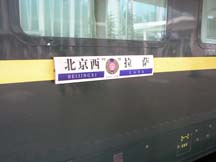
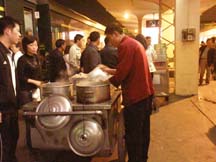
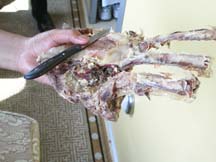
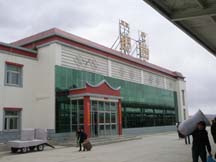
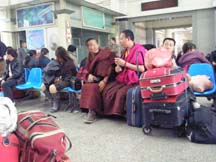 Wang Si, our China correspondent did take this train and the pictures on this page are hers. We thank her for them. She wrote that "there is lots of good food in Llasha," and we bet the trip and being there was thrilling. She has written about Tibetans and some of their food, and we suggest you read her article titled Tibetan Dietary Culture in this magazine’s Volume 16(4) on pages 5 - 7, and page 10. Her pictures are fascinating, On this page, left to right, they show the train before departing for Tibet whose elevation is above four kilometers; food for sale in that station; someone holding dried beef on the bone; two Lamas waiting for the train in Qinghai Province, and the Nagchu station in Tibet. She said she saw “no special food in the train” but was told there are eating carts on most stops such as baozi, noodles, and packaged snacks. She said “the middle picture is dried beef.” "There were ten Tibetan passengers in the car I was in, and one bought this kind of dried beef, also some tsampa made with yak butter.” She went on to say “they cut pieces off the bone in that middle picture and ate it directly from their knives immediately after cutting it off."
Wang Si, our China correspondent did take this train and the pictures on this page are hers. We thank her for them. She wrote that "there is lots of good food in Llasha," and we bet the trip and being there was thrilling. She has written about Tibetans and some of their food, and we suggest you read her article titled Tibetan Dietary Culture in this magazine’s Volume 16(4) on pages 5 - 7, and page 10. Her pictures are fascinating, On this page, left to right, they show the train before departing for Tibet whose elevation is above four kilometers; food for sale in that station; someone holding dried beef on the bone; two Lamas waiting for the train in Qinghai Province, and the Nagchu station in Tibet. She said she saw “no special food in the train” but was told there are eating carts on most stops such as baozi, noodles, and packaged snacks. She said “the middle picture is dried beef.” "There were ten Tibetan passengers in the car I was in, and one bought this kind of dried beef, also some tsampa made with yak butter.” She went on to say “they cut pieces off the bone in that middle picture and ate it directly from their knives immediately after cutting it off."
From GREG via e-mail:
Read about many minorities but never about the Axi and their love of fire. Is there such a Chinese minority, and do they really love fire?
GREG: Yes. They are a branch or sub-group of the Yi minority people, and most live in the south of the Yunnan Province in the Mile County in the Xiyi Township. They have a fire god, Mu Deng, and a special ceremony called Mizhilin with lots of wine and dancing to honor him. Incidentally, that word in their language means dense forest, the place where he existed in ancient times. We read about a man who lived there called Deng once kept himself warm drilling an old log for seventy-two hours. In those three days and three nights it unexpectedly made sparks and fire; hence their association with fire. The Axi have a special day to honor and revere Mu Deng. On that day, young men go to the forest, women stay home as do elderly men and together they prepare a feast. Families line up tables outside and call this table line their dragon or Deng, their male ancestor who lived in a dense forest. Before eating, they make a fire, pray to him for mild weather and adequate rainfall, and do ask him to join them for this dinner with much wine and energetic dancing. Women paint their foreheads with the sign of fire and ask him for protection for themselves and their crops. Long before dinner, they boil eggs in brown sugar water to entice him to visit, then eat them with their men before they go into the forest. For that outdoor dinner, large cauldrons of meat are cooked all day long cooking one or more black goats for everyone’s evening meal to be enjoyed with wine made from local grapes.
Incidentally, the Axi have other festival occasions and all of them revolve around a bonfire. Their dates vary as do their names; and no two Axi people gave us an actual date on their lunar calendar. We finally did figure out why not, seems they knew their grandparents celebrated them, but they never did.
|

 From BABA ONG JIN TEONG from Singapore:
From BABA ONG JIN TEONG from Singapore:



 Wang Si, our China correspondent did take this train and the pictures on this page are hers. We thank her for them. She wrote that "there is lots of good food in Llasha," and we bet the trip and being there was thrilling. She has written about Tibetans and some of their food, and we suggest you read her article titled Tibetan Dietary Culture in this magazine’s Volume 16(4) on pages 5 - 7, and page 10. Her pictures are fascinating, On this page, left to right, they show the train before departing for Tibet whose elevation is above four kilometers; food for sale in that station; someone holding dried beef on the bone; two Lamas waiting for the train in Qinghai Province, and the Nagchu station in Tibet. She said she saw “no special food in the train” but was told there are eating carts on most stops such as baozi, noodles, and packaged snacks. She said “the middle picture is dried beef.” "There were ten Tibetan passengers in the car I was in, and one bought this kind of dried beef, also some tsampa made with yak butter.” She went on to say “they cut pieces off the bone in that middle picture and ate it directly from their knives immediately after cutting it off."
Wang Si, our China correspondent did take this train and the pictures on this page are hers. We thank her for them. She wrote that "there is lots of good food in Llasha," and we bet the trip and being there was thrilling. She has written about Tibetans and some of their food, and we suggest you read her article titled Tibetan Dietary Culture in this magazine’s Volume 16(4) on pages 5 - 7, and page 10. Her pictures are fascinating, On this page, left to right, they show the train before departing for Tibet whose elevation is above four kilometers; food for sale in that station; someone holding dried beef on the bone; two Lamas waiting for the train in Qinghai Province, and the Nagchu station in Tibet. She said she saw “no special food in the train” but was told there are eating carts on most stops such as baozi, noodles, and packaged snacks. She said “the middle picture is dried beef.” "There were ten Tibetan passengers in the car I was in, and one bought this kind of dried beef, also some tsampa made with yak butter.” She went on to say “they cut pieces off the bone in that middle picture and ate it directly from their knives immediately after cutting it off."